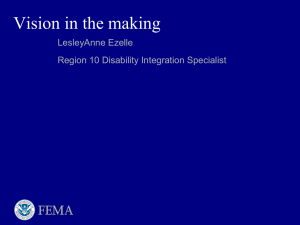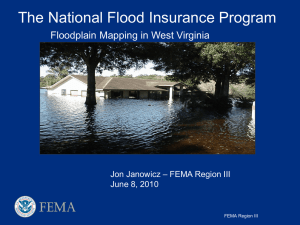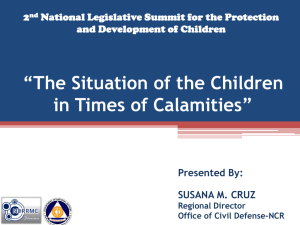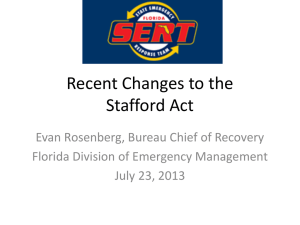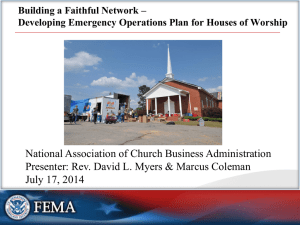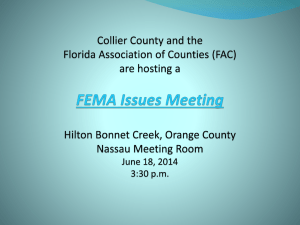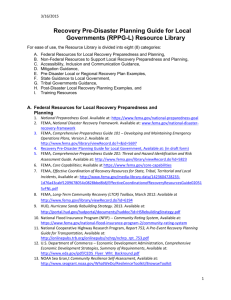Presentation title slide - 42 pt Times New Roman, White
advertisement
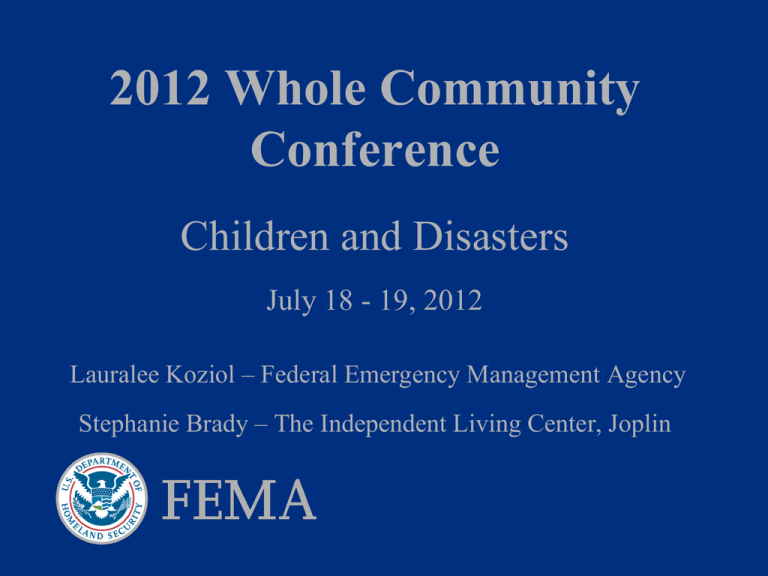
2012 Whole Community Conference Children and Disasters July 18 - 19, 2012 Lauralee Koziol – Federal Emergency Management Agency Stephanie Brady – The Independent Living Center, Joplin FEMA’s Children’s Working Group Administrator Fugate established FEMA’s Children’s Working Group in August 2009 - comprised of a Chair, Lead Coordinator and participants representing virtually all Directorates and Offices throughout FEMA Responsible for leading FEMA’s efforts, in partnership with other Federal agencies and non-governmental organizations to ensure that the needs of children were considered and integrated into overall disaster planning, preparedness, response and recovery efforts initiated at the Federal level. Coordinated and collaborated closely with experts from other Federal agencies and stakeholders to address and elevate the needs of children as they relate to disasters. FEMA’s Children’s Working Group Children integrated into several planning and guidance documents to include, Comprehensive Preparedness Guidance (CPG) 101 v.2 – serves as a framework for all planning guidance FY 2010 – FY 2012 Homeland Security Grant Program Guidance and Children in Disasters Supplemental Resource – provides clarification as to how grant dollars may be used to support preparedness and planning activities for children National Response Framework, National Disaster Recovery Framework and other Presidential Policy Directive (PPD) 8 Frameworks – focus on a unified and collaborative approach of addressing our Nation’s disaster related resources by engaging the whole community FEMA’s Children’s Working Group Availability and pre-staging of infant and toddler supplies, consumable medical supplies, and durable medical equipment – planning is inclusive to all populations within the community Partner closely with Departments of Education, Health and Human Services and Justice to support the development of emergency preparedness plans and overall efforts of addressing children’s disaster related needs during peace time and in disasters FEMA has clarified reimbursement eligibility for child care services under the Stafford Act – “emergency sheltering” Lessons Learned and Information Sharing – “Children and Disasters” webpage Youth Preparedness http://citizencorps.gov/getstarted/youth/youthindex.shtm Catalogue of Programs: Lists existent programs throughout the country Youth to the Forefront Literature Review: Research-based resource of youth and disasters information from various academic sources Community Preparedness Webinar Series: Include school-specific webinars Ready Kids: Geared toward children and families, provides resources to develop a family plan, build an emergency kit, and play preparednessrelated games Readiness and Emergency Management for Schools Technical Assistance Center: Center is run by the Department of Education’s Office of Safe and Healthy Students, provides technical assistance for schools, school districts, and institutions of higher education and addresses emergency management issues and questions Reunification In late 2005, Hurricanes Katrina and Rita struck the Gulf Coast area of the United States causing the displacement of tens of thousands of individuals from their homes and communities Approximately 5,000 children were separated from their parents / legal guardians. Within hours, the Department of Justice requested that the National Center for Missing and Exploited Children (NCMEC) establish a hotline to handle calls of displaced children and adults As a result of NCMEC’s efforts, the last of the 5,192 children displaced by the storm was reunited with her family in Houston, TX in March 2006 Post-Katrina Emergency Management Reform Act of 2006 1) In general - Not later than 180 days after the date of enactment of this Act, the Administrator, in coordination with the Attorney General of the United States, shall establish within the National Center for Missing and Exploited Children the National Emergency Child Locator Center. In establishing the National Emergency Child Locator Center, the Administrator shall establish procedures to make all relevant information available to the National Emergency Child Locator Center in a timely manner to facilitate the expeditious identification and reunification of children with their families. FEMA and NCMEC Execute a Formal Agreement in April 2011 Allows FEMA to reimburse NCMEC for the deployment of personnel to a Presidentially declared disaster to assist law enforcement with the reunification of displaced children – NO cost share Additional resources include workspace in a FEMA Joint Field Office, Regional Office and/or Warm Cell location for NECLC personnel to deploy resources and streamline communications and coordination Ability to coordinate more effectively and efficiently with Federal, State, and non-governmental partners to ensure the safety of our nation’s children Post Disaster Reunification of Children: A Nationwide Approach National initiative created in January 2012 to support FEMA/NCMEC agreement and facilitate the expeditious reunification of children separated as a result of disaster Can be applied to existent emergency preparedness plans and reunification procedures Consistent with Presidential Policy Directive (PPD) 8 Development team consisted of Federal, State, and non-governmental organizations Document shared in April 2012 with all FEMA Regions, child and disability advocates, voluntary organizations, children’s hospitals, and others Post Disaster Reunification of Children: A Nationwide Approach Assist local and State governments in determining processes, communication lines, and the identification of roles and responsibilities necessary to facilitate the expeditious reunification of children separated as a result of disaster Encourage stakeholders and community leaders to develop and build upon existent relationships prior to a disaster Establish an understanding of how all responsible parties (leading and supporting) can work together to support each other’s missions Identify tools and resources that could assist localities and States in disaster related reunification efforts (i.e.., tracking & reunification systems) Unaccompanied Minors Registry (UMR) Supports the ability to collect, store, report, and act on information related to children missing or lost as a result of a disaster Allows for a more expedient and efficient reunification of unaccompanied minors with their families and legal guardians when separated by a disaster Administered by the NCMEC and available during “ALL” disasters to gather and share information with local law enforcement and assist in the reunification of displaced children with their families or legal guardians. Urban Search and Rescue (USAR) and Team Adam Applications UMR Portal Approximate date of completion – late July/early August 2012 Rollout – Fall 2012 Make A Plan Families may not be together when disaster strikes, so it is important to plan in advance: how you will contact one another; how you will get back together; and what you will do in different situations Family Plans can be found on Ready.gov http://www.ready.gov/america/makeaplan/index.html Encourage educational, child care, medical, and recreational facilities responsible for the temporary care of children to share emergency preparedness plans with parents and legal guardians Joplin, Missouri 2011 Pre-Disaster Coordination Efforts COAD Participation (Community Organizations Active in Disaster) Jasper/Newton County Healthcare Coalition—Emergency Response Team CERT Training (Community Emergency Response Teams) Red Cross Volunteer Training Center and Community Emergency Plans Consumer Comprehensive Emergency/ Disaster Plans Disability Resource Council What went well in Response FACEBOOK and Bright Futures/Rebuild Joplin Website!!! TILC had nearly immediate contact with Gay Jones, FEMA Disability Integration Specialist with the Office of Disability Integration and Coordination www.fema.gov/about/odic/ Joplin Public Schools Used School Buses to Transport People TILC Sister Organizations assistance with search and rescue, debris removal, location of consumers, delivering replacement equipment, etc. TILC made contact with the American Red Cross within three hours of the disaster to transport people with disabilities and to deliver medical equipment to shelters TILC staff and other disability groups set up resources at the shelter and the Multi-Agency Resource Center to provide intake and information What went well in Early Recovery FEMA worked with various community and city groups to develop task forces to facilitate recovery. (Housing Task Force, School and Facilities Task Force, etc.) Crucial for disability organizations to participate in each task force! TILC worked with the Housing Task force and the Disability Group to develop a housing intake sheet to determine emergency housing needs as well as priorities for the FEMA Temporary Housing Units Coordinating with FEMA to offer alternative options for registering for assistance (mobile DRC, etc.) Trained FEMA CR staff in disability awareness FEMA THU accessibility I Am Joplin Temporary Schools Temporary school facilities opened on August 17 – temporary facilities are equipped with tornado shelters and built to ensure that the shelters are easily accessible Every school opened on time as promised by the school administration (6 public schools) Every student with a disability in public schools started on time School and Bus Buddies for kids with access and functional needs New School Accessibility & Safe Rooms
